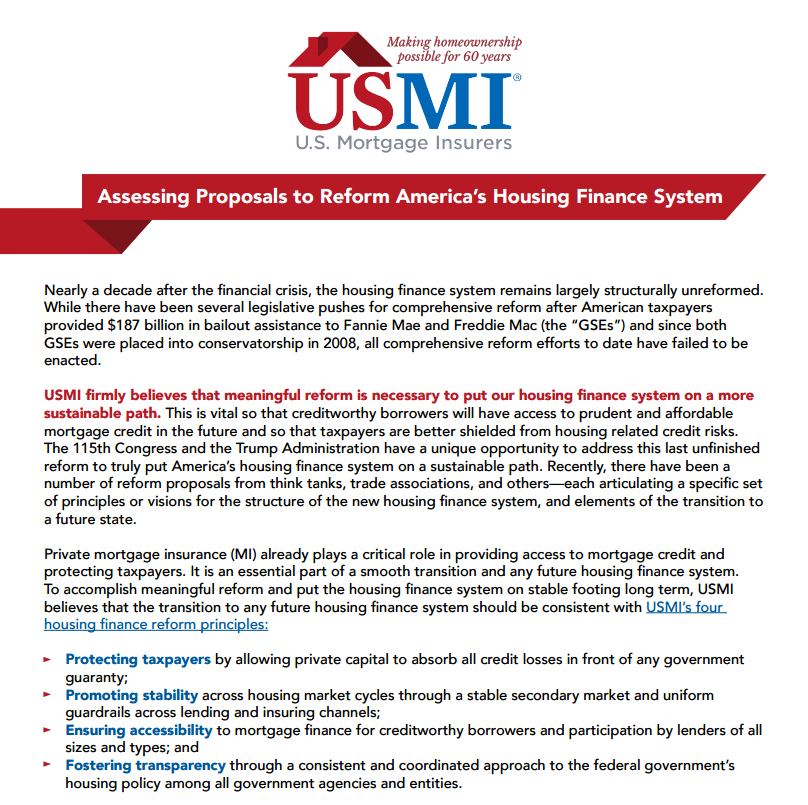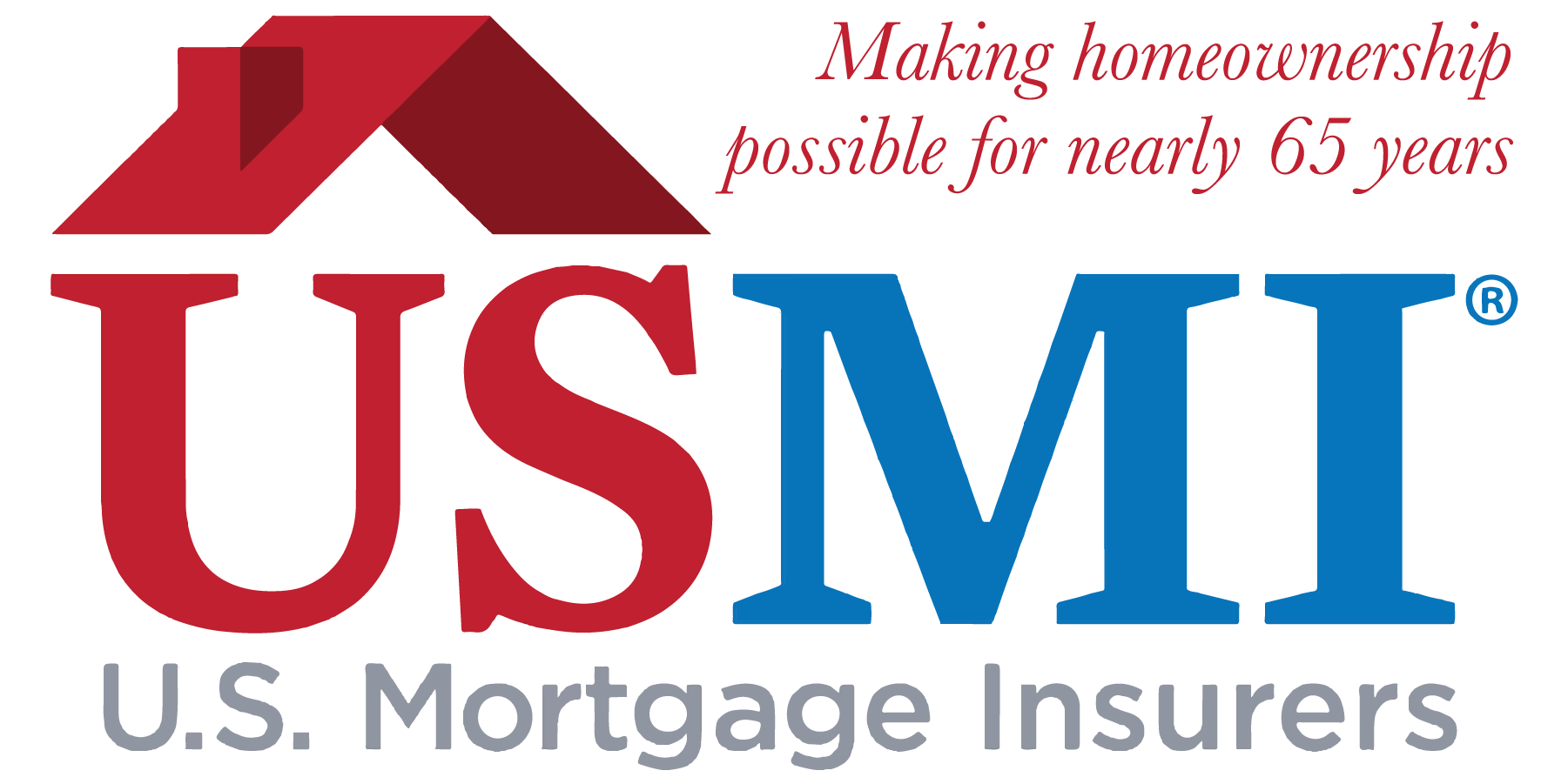by Patrick Sinks, President and CEO, MGIC and Chairman of USMI
Since the 2008 financial crisis, certain safeguards were put in place that resulted in more stringent underwriting standards for lenders and borrowers. As a mortgage insurer, lenders are my customers. For borrowers who don’t put 20% down – which is not a requirement – and are viewed by lenders as higher credit risk, mortgage insurers reduce or eliminate losses by providing protection to the lender in the event of a foreclosure. In doing so, mortgage insurance (MI) allows qualified homebuyers with low down payments (borrowers can put as little as 3% down with mortgage insurance) to qualify for mortgages because of the guarantee mortgage insurers provide to the system. If a borrower ends up suffering a foreclosure, we are in the so-called “first loss” position, and pay claims to the affected lender.
Today, there is a discussion in Washington about reforming some of the more far-reaching and costly regulations associated with the Dodd-Frank Act, including the Qualified Mortgage (“QM”) rule. To be sure, as a mortgage insurer, we have witnessed the difficulty within the mortgage lending sector to understand, implement, and comply with all the new rules and regulations, all the while ensuring mortgage credit remains available. Safe and prudent lending standards must remain intact throughout the system to avoid another housing crisis, though we must also ensure affordable mortgages don’t become out of reach for creditworthy buyers. There is a balance that must be struck. Three years after the QM rule was adopted, it is highly appropriate for industry and policymakers to ensure that there remains a balance between prudent lending and access to credit.
What the QM Rule Does
The QM rule for conventional mortgages, which was promulgated by the Consumer Financial Protection Bureau (CFPB), went into effect in January 2014 to protect borrowers, lenders, and the U.S. financial system, from risky lending practices that contributed to the housing crisis and its ripple effects throughout the economy.
Also known as the “ability to repay” rule, QM takes into account a borrower’s risk and financial situation, prohibits the use of some of the riskiest types of mortgage from the pre-2008 era, and provides legal protections for lenders if they meet strict underwriting standards.
Because of these features, qualified mortgages sold into mortgage-backed securities guaranteed by Fannie Mae and Freddie Mac (government-sponsored entities, or “GSEs”), are designed as safer investments with less risk exposure to the federal government, and therefore create less risk to taxpayers. During the financial crisis, prior to the QM rule’s existence, the GSEs took a combined $187 billion taxpayer bailout when riskier mortgage loans that the GSEs guaranteed devalued, creating catastrophic losses.
How Does the Current QM Rule Work?
To prevent government and taxpayer exposure to such housing credit risk, the QM rule requires strong underwriting standards that take into account a borrower’s financial profile, such as credit score, as well as establishes requirements for processes that lenders must follow when originating a mortgage. According to the CFPB, the general requirements needed for making a qualified mortgage include:
- Good-faith determination of a borrower’s “ability to repay” his or her mortgage
- No excessive upfront fees
- Elimination of certain loan features, including “interest-only” payment periods, negative amortization, balloon payments, and loan terms longer than 30 years
- Legal protections for lenders
Why Lending Standards are Critical
The safeguards that came into the marketplace for borrowers, lenders, investors, and ultimately taxpayers with the implementation of the QM standard have been helpful in improving the credit quality of the housing market in the United States. Since the QM rule went into effect, the default rate on loans held by the GSEs has dramatically declined. For example, for mortgages originated at the height of the housing crisis in 2007, the cumulative default rate on loans held by Fannie Mae totaled 14.4%, while for Freddie Mac it was 8.3%. Following the enactment of the CFPB’s QM rule in January 2014, the cumulative default rates for the loans backed by the GSEs have fallen to nearly zero in 2015 and 2016. As noted before, while there have been improvements to credit quality, legitimate concerns are being raised by many stakeholders about whether mortgage credit has become too restricted. The average FICO credit score of a Fannie Mae and Freddie Mac low down payment borrower is over 750, which by all accounts is considered excellent credit. These questions on the access to credit underscore the need to review underwriting standards to ensure they do not overly restrict credit to creditworthy borrowers leaving the question of whether the pendulum has swung too far.
Uniform Lending Standards are Important
While consistency and uniformity are important to nearly all industries, there is a great need for uniform lending standards and rules in the housing finance industry. Currently, the CFPB and the Department of Housing and Urban Development (HUD) have QM rules that are not uniform, which leads to gross inconsistencies in the housing finance industry. For example, the Federal Housing Administration’s (FHA) upfront mortgage insurance premium is excluded from the QM rule’s cap on points and fees, while the private MI upfront premium is included. This inconsistency effectively precludes the financing of MI premiums into the loan amount, leading to higher monthly payments for borrowers. If the QM rules are changed, it should be to align underwriting standards for GSE-backed loans and loans backed by the FHA, which are 100% government-guaranteed. The same standards should be applied to both the GSEs and FHA, given they effectively serve the same low down payment borrowers.
Keep Prudent Lending Standards Intact
Mortgage insurers are required by law to build contingency reserves, meaning that in addition to the capital our companies are required to hold against the risk we insure, a portion of every premium dollar received is reserved specifically for emergencies on a countercyclical basis. In 2015, the Federal Housing Finance Agency (FHFA) implemented even stronger capital requirements called Private Mortgage Insurance Eligibility Requirements (PMIERs), which nearly doubled the amount of capital required for MIs to be approved to insure loans acquired by the GSEs. PMIERs, regulators affirm, reduce Fannie Mae and Freddie Mac’s risk exposure. The same can be said of the QM rule.
The MI industry fully appreciates the impact of the QM rule, and what it takes for lenders to conduct business within the boundaries of the rule, while working to provide access to mortgage credit to homebuyers. Lenders and others in the mortgage finance business are not the only ones impacted by new standards. New rules mean consumers could face different or tightened credit, making it longer to qualify for a mortgage. For some borrowers, new rules mean enhanced lending standards.
The QM rule has and will continue to be a solid foundation for responsible underwriting and borrowing in our housing system. As new housing policy or reforms to existing policies are considered, it is important that the foundations of the QM rule remain intact while also balancing the need to ensure creditworthy borrowers aren’t unnecessarily or unintentionally left on the sidelines.














